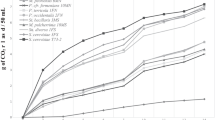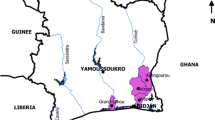Abstract
Yeasts involved in velum formation during biological ageing of sherry wine have to date been classified into four races of Saccharomyces cerevisiae (beticus, cheresiensis, montuliensis, rouxii) according to their abilities to ferment different sugars. It has been proposed that race succession during biological ageing is essential for the development of the organoleptical properties of sherry wines. In this work we studied the physiological characteristics, the molecular differentiation and the phylogenetic relationships of the four races employing type and reference strains from culture collections and natural environments. Using restriction analysis of the ribosomal region that includes the 5.8S rRNA gene and internal transcribed regions (5.8S-ITS) we were able to differentiate ‘flor’ and non-‘flor’S. cerevisiae yeast strains. However, no correlation between fermentation profile, mitochondrial DNA restriction analysis or chromosomal profiles and these races was found. Moreover, sequences of the D1/D2 domain of the 26S rRNA gene and the 5.8S-ITS region from these strains were analysed and no genetic differences were noted suggesting that ‘flor’ yeast cannot be grouped into four different races and the four races are identified as S. cerevisiae. Since the yeasts isolated from velum in sherry wine present a unique 5.8S rRNA pattern different from the rest of the Saccharomyces cerevisiae strains we propose that they should be included as a single race or variety inside the S. cerevisiae taxon.
Similar content being viewed by others
References
Aranda A., Querol A. and del Olmo M. 2002. Correlation between acetaldehyde and eternal resistance of HSP genes in yeast strains isolated during the biological ageing of sherry wines. Arch. Microbiol. 177: 304-312.
Barnett J.A. 1992. The taxonomy of the genus Saccharomyces Meyen ex Ress: a short review for non taxonomist. Yeast 8: 1-23.
Barnett J.A., Payne R.W. and Yarrow D. 1990. Yeast: Characteristics and Identification. 2nd edn. Cambridge University Press, Cambridge.
Carle G.F. and Olson M.V. 1985. An electrophoretic karyotype of yeasts. Proc. Natl. Acad. Sci. USA 82: 3756-3760.
Esteve-Zarzoso B., Belloch C., Uruburu F. and Querol A. 1999. Identification of yeasts by RFLP analysis of the 5.8S rRNA gene and the two ribosomal internal transcribed spacers. Int. J. Syst. Bacteriol. 49: 329-337.
Esteve-Zarzoso B., Peris-Torán M.J., García-Maiquez E., Uruburu F. and Querol A. 2001. Yeast population dynamics during the fermentation and biological ageing of sherry wines. Appl. Environ. Microbiol. 67: 2056-2061.
Fernández-Espinar M.T., Esteve-Zarzoso B., Querol A. and Barrio E. 2000. RFLP analysis of the ribosomal internal transcribed spacer and the 5.8S rRNA gene region of the genus Saccharomyces: a fast method for species identification and the differentiation of 'flor' yeasts. Antonie van Leeuwenhoek 78: 87-97.
Ibeas J.I., Lozano I., Perdigones F. and Jiménez J. 1997. Dynamics of 'flor' yeast populations during the biological ageing of sherry wines. Am. J. Enol. Vitic. 48: 75-79.
Kimura M. 1980. A simple method for estimating evolutionary of base substitution through comparative studies of nucleotide sequences. J. Mol. Evol. 16: 111-120.
Kreger-van Rij 1984. The Yeasts. A Taxonomic Study. 3rd edn. Elsevier, Amsterdam.
Kumar S., Tamura K., Jakobsen I.B. and Nei M. 2001. MEGA2: Molecular Evolutionary Genetics Analysis software. Bioinformatics 12: 1244-1245.
Kurtzman C.P. and Fell J.W. 1998. The Yeasts. A Taxonomic Study. 4th edn. Elsevier, Amsterdam.
Kurtzman C.P. and Robnett C.J. 1998. Identification and phylogeny of ascomycetous yeasts from analysis of nuclear large subunit (26S) ribosomal DNA partial sequences. Antonie van Leeuwenhock 73: 331-371.
Lodder J. 1970. The Yeasts. A Taxonomic Study. 2nd edn. North-Holland Publ. Co., Amsterdam.
Martínez P., Codón A.C., Pérez L. and Benítez T. 1995. Physiological and molecular characterization of 'flor' yeasts: polymorphism of 'flor' yeast populations. Yeast 11: 1399-1411.
Martínez P., Pérez-Rodriguez L. and Benítez T. 1997a. Evolution of 'flor' yeast population during the biological ageing of fino Sherry wine. Am. J. Enol. Vitic. 48: 160-168.
Martínez P., Pérez-Rodriguez L. and Benítez T. 1997b. Velum formation by 'flor' yeasts isolated from sherry wine. Am. J. Enol. Vitic. 48: 55-62.
Querol A., Barrio E., Huerta T. and Ramón D. 1992. Molecular monitoring of wine fermentations conducted by active dry yeast strains. Appl. Environ. Microbiol. 58: 2943-2953.
Thompson J.D., Higgins D.G. and Gibson T.J. 1994. Clustal W: improving the sensitivity of progressive multiple sequence alignment through sequence weighting, positions-specific gap penalties and weight matrix choice. Nucleic Acids Res. 22: 4673-4680.
Author information
Authors and Affiliations
Rights and permissions
About this article
Cite this article
Esteve-Zarzoso, B., Fernández-Espinar, M.T. & Querol, A. Authentication and identification of Saccharomyces cerevisiae‘flor’ yeast races involved in sherry ageing. Antonie Van Leeuwenhoek 85, 151–158 (2004). https://doi.org/10.1023/B:ANTO.0000020282.83717.bd
Issue Date:
DOI: https://doi.org/10.1023/B:ANTO.0000020282.83717.bd




